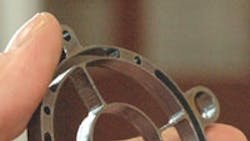The challenge lies in rethinking old laser cutting strategies. That approach brought success to Stock Manufacturing when it found itself running out of laser cutting capacity.
Instead of adding a third machine, the owners of the contract fabricating shop elected to add more hours of productivity to their two existing Cincinnati Inc. lasers. Stock Manufacturing became the first customer for Cincinnati's newly developed automated material handling system.
The Modular Material Handling System (MMHS) allows Stock's two lasers to run eight hours a day attended and another 12 hours unattended, plus long periods unattended over the weekend as workloads require.
"By our analysis, this was a four-for-the-price-of-three deal," says Dennis Stock, one of the three brothers who own and operate the company. "The automated system cost us about the same as a third laser would have," he explains. "We're now getting productivity equal to four lasers running two shifts a day, while staffing just for two machines."
The robot transporter features an arm with long, closely spaced fingers to support and control the sheets. Stock Manufacturing added a creative touch by programming in a "pop" when lifting finished sheets. That bumping action breaks loose any parts or slugs that get welded to the table grid.
Stock's MMHS is configured so that finished parts can be transported to one of three unload stations or back to the elevator for tower drawer storage.
See Also
